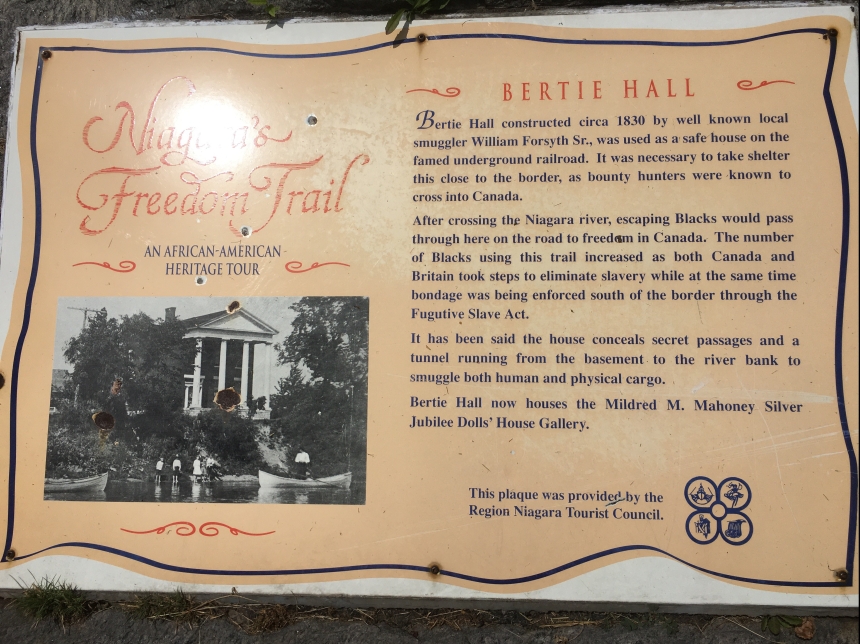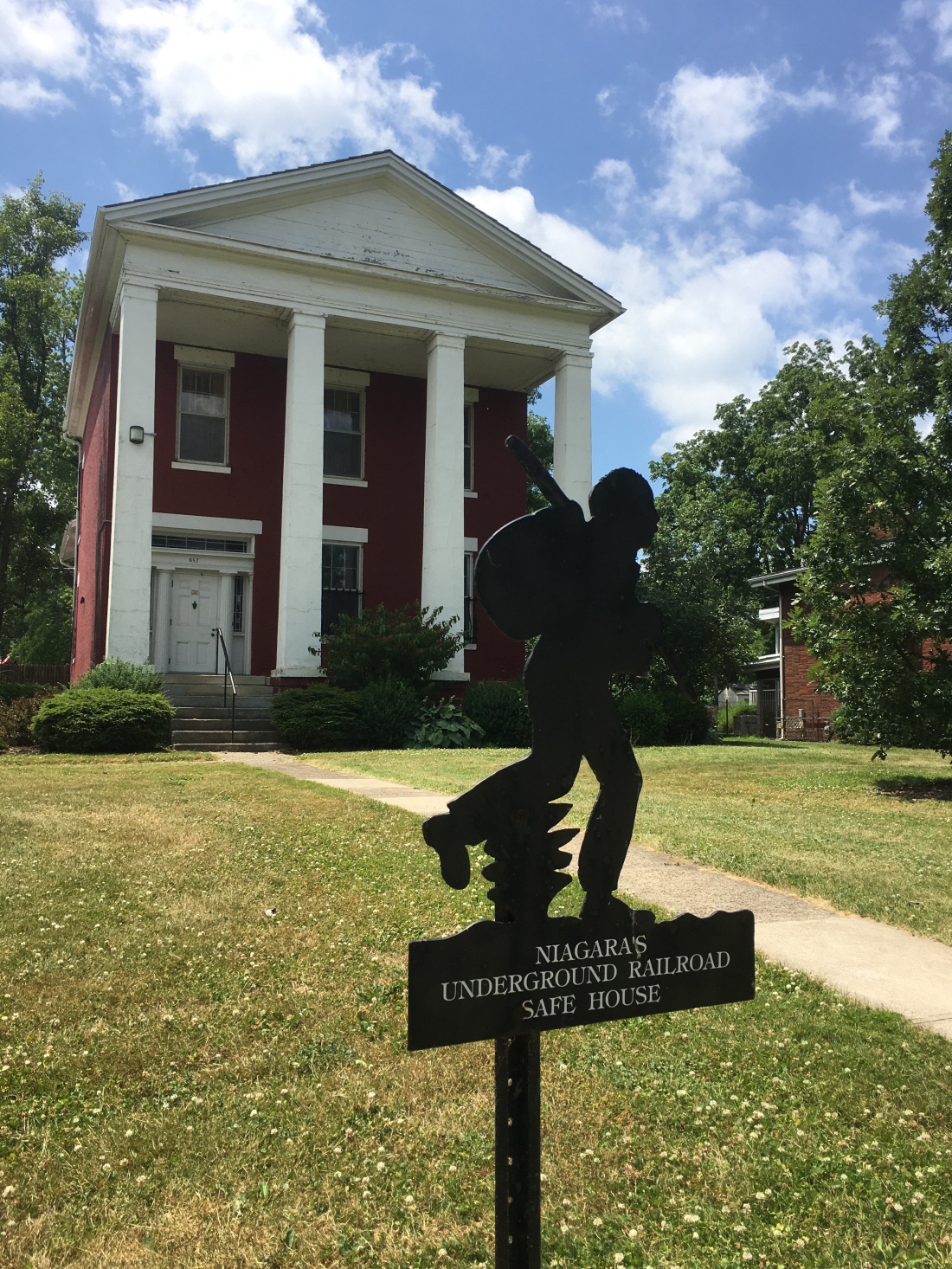On the corner of Phipps St. and Niagara Blvd in Fort Erie stands a Greek Revival mansion named Bertie Hall. A legendary Niagara home with a long history, Bertie Hall was a safe house to slaves escaping into Canada via the Underground Railroad. The house has seen many lives pass through its doors and tales of paranormal activity abound.
The property was purchased in 1832 (2) by William Forsyth a Niagara entrepreneur with a long and complicated history. According to the records, Forsyth owned the Table Rock area of Niagara Falls, building a luxury hotel with exclusive views of The Falls. Court challenges with the government meant that Forsyth lost his exclusivity and sold out to the competition. (1) He took his earnings and moved farther along the Niagara river towards Fort Erie where he built Bertie Hall.

Bertie Hall was a luxurious dwelling constructed on the banks of the Niagara River. The interior included Italian marble fireplaces and a 22-foot curved staircase with handrails made from black walnut. The expansive home housed his family, which at one point included 19 children. Though it is unclear if the whole family resided there simultaneously.
Legend has it that there is an underground tunnel in the basement, which allowed escaping American slaves to cross over into Canada and use the basement of Bertie Hall as a respite on their journey into freedom. There are no historical records to back up this claim, however the stories are well ingrained in local folklore.
There is a story that tells of a young boy who drowned in the tunnel, possibly William Forsyth’s son. This tragic circumstance it is said, resulted in the tunnel being sealed off, leaving it undiscovered today. One therefore wonders if the legend of its existence was just a local story or a reality passed down through the generations.
There is however a room in the basement that is hidden behind a bookcase. This room it is said, housed the escaped slaves and kept them hidden during a dangerous time when bounty hunters roamed the shoreline on both sides of the Niagara River.
Bertie Hall was locally known as the “Smuggler’s House” during that time. It is unclear whether the term smuggling referred to the smuggling of slaves or the smuggling of goods. Historical records refer to the possibilities of both, as the Forsyth family were thought, at the time, to use dubious business practices.
I wonder if the crossing at Bertie Hall existed prior to the mansion when there was perhaps a less spectacular home on the property. This area of Fort Erie historically known as the Village of Waterloo, sits directly across from Black Rock in Buffalo NY and was a well-known gateway enabling the escape of black slaves from America into Canada via the Underground Railroad.

A well-known historical figure connected to the Underground Railroad is Josiah Henson. An escaping slave, Josiah crossed over into Canada from Black Rock in 1830. His incredible life story is a must read via his autobiography and you can read some of it here in a previous blogpost.
I am intrigued by Josiah Henson’s connection to Bertie Hall, because although the mansion as it is today was not constructed at the time of Josiah’s arrival, he did continue to help other US slaves escape into Canada via the Underground Railroad and did work in Niagara throughout the 1830s. Which leads to the question of his connection with Bertie Hall.
The current owner of Bertie Hall, the Niagara Parks Commission is one in a list of interesting owners. Subsequent to the Forsyths, the house was the Mildred Mahoney Doll Gallery. It was during the existence of the doll museum that paranormal activity became apparent. Some of this activity has been documented and several witnesses tell of the happenings they experienced firsthand.
Sounds of footsteps, movement of furniture to other sides of the room, cold spots, movements on the staircase, and other eerie happenings have been recorded by psychics, ghost hunters and other interested individuals. A very interesting podcast by Unsolved Mysteries, regarding these events can be found at the link below (3).
Today the house stands still and forlorn, the residuals of a more prosperous time for the man who brought it to life and who did not live long there. William Forsyth died in 1841. And Josiah Henson moved away from Niagara in 1842. What remains among the whispering cobwebs are the many spirits that now reside there and the stories they could tell. If only.
If you know anything about the history of Bertie Hall please share. It’s a fascinating tale.
Address: 657 Niagara Blvd. and also 16-22 Phipps St. Fort Erie, ON
- Biography of William Forsyth
http://www.biographi.ca/en/bio/forsyth_william_1771_1841_7E.html
2) History of the Land and Home
http://www.fepl.ca/localhistory/files/original/115ea1a9b9695cea810af54179e8b43b.pdf
The FELP website also offers historical images of the exterior and interior of Bertie Hall. Access them starting here.
http://www.fepl.ca/localhistory/items/show/376
3) Podcast with lots of info on the eerie happenings and the history of Bertie Hall
https://shows.acast.com/unsolved-mysteries-of-the-world/episodes/bertie-hall-fort-erie


Waiting to visit once travel opens up
LikeLiked by 1 person
It’s such a waiting game. Hoping soon.
LikeLike
Very interesting place to see.
LikeLiked by 1 person
It is a fascinating story. Hopefully you’ll get the chance to visit in the future.
LikeLike
Once we can get going.Thanks
LikeLiked by 1 person